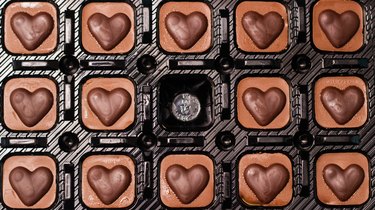
It's easy to combine two already wonderful elements and come up with something even better. Apples and cinnamon? A match made in heaven. Peanut butter and jelly? A slam dunk. Chocolate and wine? Um... That one's a bit more complicated. A good pairing can be heavenly, but an unfortunate one can set your teeth on edge and spoil your enjoyment of both.
Chocolate and wine both have deeply complex and nuanced flavors, which makes properly pairing the two a challenge. Chocolate can have thousands of flavor profiles, depending on how and where it's grown and prepared. Belgian dark chocolate, for example, often features fruity, wine-like notes. Meanwhile, Dutch chocolate tends to be earthier. Chocolate can be sweet and cloying, austere and almost bitter or nutty or coffee-like. And that's before considering additional ingredients such as dried fruits and nuts!
Video of the Day
Video of the Day
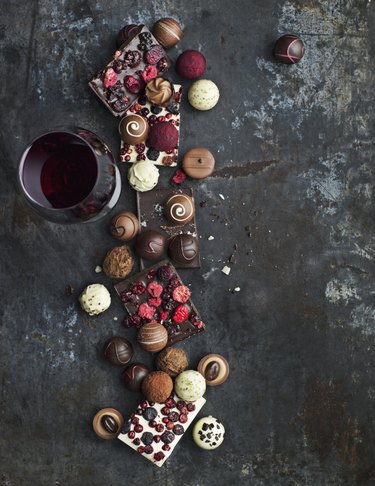
Wine is also famously complex, containing fruity, buttery, leather-like, nutty, earthy or astringent notes—to name just a few—while simultaneously ranging from mouth-puckeringly dry to lush and sweet. There's a lot to keep track of when it comes to wine and chocolate, which means there are plenty of ways for the unsuspecting novice to create a jarring mismatch.
Luckily, we're here to help with an overview of chocolate and wine pairings—and accessible tips for mixing and matching. Understanding a few basics—don't think of them as rules—can help you stack the odds in your favor.
Checklist: Chocolate and Wine Pairings
Here are some things to consider when pairing chocolate and wine.

1. Sweetness
White chocolate, milk chocolate and chocolate-flavored desserts tend to be the sweetest. Dark chocolate begins at 35% cocoa—less sweet than milk chocolate but still sweet—and extends to 80% or higher for more bitter varieties. Wines, for their part, range from intensely sweet dessert wines to off-dry and demi-sec to bone-dry.
The bottom line? Try to match the sweetness of the chocolate and the wine, pairing the sweetest wines with the sweetest chocolates. If anything, try to make the wine slightly sweeter than the chocolate: The chocolate will typically neutralize the wine's sweetness, bringing out elements of its character that are masked by its sugars.
2. Intensity
A welterweight boxer will always be in tough straits against a heavyweight, and the same broad principle applies to chocolate and wine pairings. Wines vary widely in their intensity and in the sensation of "weight" or body they create on your palate. Italian wines can range from a light and fruity Lambrusco to a bold and bitter amarone, while California wines might offer anything from a light and fresh Pinot Noir to a big, brooding Petite Syrah. Similarly, chocolates can be relatively lightweight (think milk chocolate or some of the lower-cocoa dark chocolates) while high-cocoa chocolates pack a serious punch.
When pairing, try to match wines and chocolates with similar levels of intensity or "palate weight." Lighter chocolates work well with lighter wines, while heavyweight wines and chocolates can stand up to each other without being overwhelmed. If you're creating multiple pairings, start with the lightest and work your way toward the most intense.
3. Tannins
Here's where things get trickier. Tannins are organic molecules in some wines (mostly reds) that give them their astringent, mouth-drying character. They're very similar to compounds in dark chocolate that add faint hints of bitterness. Matching an astringent dark chocolate with an astringent red wine is where the risk and rewards are highest. Some combinations are simply transcendent.... If you get it right. If you get it wrong, it will be wrong on a "toothpaste and orange juice" level.
The safe call is to opt for softer, fruitier wines with low to moderate tannins (often described as "easy-drinking" in their advertising). These can be safely paired with a wider range of chocolates. If you want to go for the gusto and match a bold red wine with an intense dark chocolate, look for very specific combinations from experts ("this exact wine with this exact chocolate") or fall back on trial and error. If you're planning a special occasion with your sweetheart, do this in advance so you'll know your combination works. If it's a social night with friends, you have the latitude to try multiple wines with a given chocolate and make that quest the point of your evening.
Part 1: White Chocolate & Wine Pairings

White chocolate consists of cocoa butter—the fat that's left when you take out the actual cocoa—mixed with cream, sugar and usually vanilla. Cocoa butter gives chocolate its rich texture, and good white chocolate creates the same sensation. Lower-priced white chocolate sometimes replaces part of the cocoa butter with other fats, so keep this in mind while considering options. When in doubt, choose the shorter ingredient list.
Because white chocolate is sweet but relatively uncomplicated, it's easy to match. Your options include:
1. Dessert wines
These are meant to be paired with sweet foods, so they're an obvious starting point. Think in terms of ice wine, a sweet sherry (try a Pedro Ximenez) or a rich, sweet late-harvest wine like one of the sweeter Rieslings. Chocolate masks much of the sugar in sweet wine, bringing out fruit and bright acidity that might otherwise be concealed.
2. Off-dry whites and rosés
These aren't as sweet as outright dessert wines, but they'll still stand up to white chocolate. Options include Rieslings and Gewürztraminers, muscat/moscato and slightly sweet rosés from various regions. Another option are off-dry (demi-sec) sparkling wines, such as Brachetto d'Acqui and Moscato d'Asti. Their effervescence plays nicely with the richness of white chocolate, and they have enough sweetness to retain much of their usual character.
3. Riskier options
Dry sparkling wine isn't a natural pairing for white chocolate, but some varieties have a pronounced "toastiness" that can work with rich, buttery white chocolate. You might try a similar white chocolate with an oaky, buttery Chardonnay. (Some will work, some won't, so be prepared to experiment.) You might even opt for contrast and pair with a big, bold dry red: a tannic Cabernet Sauvignon, perhaps, or a high-alcohol California Zinfandel. When that sort of pairing comes together, the richness of white chocolate smooths out rough edges in the wine.
Part 2: Milk Chocolate & Wine Pairings
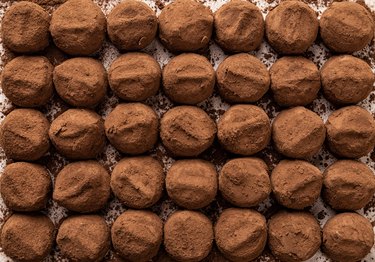
White chocolate isn't for everybody while dark chocolate can be a bit too intense for some, but almost everyone likes milk chocolate. It's equally as easygoing and approachable as a wine pairing, likely making it your most versatile, safe option.
Wine pairing options for milk chocolate include:
1. Supple, fruity red wines
Remember when we spoke of "easy-drinking" red wines? This is your opportunity to bring out something fresh and fruity like a Pinot Noir, a Beaujolais, a Merlot or a South American Carmenère. Even a relatively bold Shiraz (aka Syrah) or Zinfandel can work, as long as it's fruit-forward and not too assertive. Fresh, fruity wine should complement chocolate's creaminess.
2. Dessert wines
The same dessert wines that work with white chocolate will work with milk chocolate—and you can even add a few others that would overpower white chocolate. One example is Banyuls, a red dessert wine from France. Another (and arguably the most classic pairing) would be a ruby port, but tawny ports and other fortified wines, such as Madeira or Marsala, will pair nicely.
3. White wines
Fruit-forward white wines can work just as well with milk chocolate. It's probably best to avoid steely-dry whites like sauvignon blanc, but Gewürztraminer's lush fruitiness, a light and crisp Pinot Gris/Pinot Grigio or even boxed white table wine can mesh surprisingly well.
Part 3: Dark Chocolate & Wine Pairings

Dark chocolate presents a challenge because of its assertiveness. Ordinary dark chocolate bars from the supermarket start at around 35% cocoa, which is low enough that many wine pairings used with milk chocolate remain acceptable. It gets more difficult as cocoa levels increases, though, and anything from 80% onward is all but un-pairable. Leave those to the experts, and stick with chocolate that falls into the 55–70% range. While these percentages are still challenging, they're novice-friendly.
A few viable strategies for pairing wine with dark chocolate include:
1. Pairing like with like
If your chocolate of choice has—for example—notes of dark berries in it, try matching it with a red wine that has those same notes.
2. Seeking contrast
The opposite strategy can also work. Chocolate with fruity notes can be paired with a wine that's relatively austere, while a fruit-forward wine makes a great complement for dark chocolate with deep, earthy notes.
3. Matching for intensity
Try pairing relatively low-key dark chocolate (about 50 or 55% cocoa) with mid-weight reds like Pinot Noir or Merlot. Big, bold dark chocolates at 70 or 75% can play surprisingly well with fruity wines like California Zinfandel. Zins from the Lodi region are actually known for being chocolate-friendly.
4. Sticking with dessert wines
When in doubt, dessert wines are a safe choice. Think in terms of a good sherry, Italian "Vin Santo" or port—along with port-style wines from other regions. Vintage port or "late bottle vintage" wines are safe bets, as are tawny ports. They're less sweet and more complex, which makes them well-suited for not-so-sweet chocolate. You might even try sweet vermouth or similar aperitif-style wine. These varieties' herbal and spicy flavors can create a winning combination when paired with complex chocolate.
Part 4: Specialty Chocolate & Wine Pairings
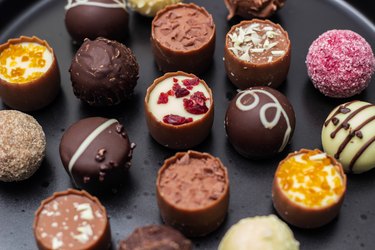
Of course, chocolate won't always be just chocolate. You might opt for chocolate with added ingredients such as nuts, caramel or dried fruit and berries. For these specialty options, look for wine that pairs nicely with add-ins as well as the chocolate itself.
1. Chocolate with fruit and nuts
Oxidized dessert wines like sherry or tawny port often have nutty and raisin-y notes, for example, and pair well with nuts or dried fruit.
2. Truffles
Truffles are typically made with dark chocolate, but they contain a lot of cream. Treat them as you would a milk chocolate or a lower-cocoa dark chocolate.
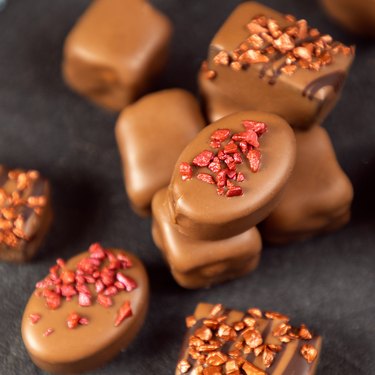
3. Chocolate-dipped strawberries
This is an interesting case because you're primarily pairing wine with the fresh taste of the strawberry, while the chocolate takes a secondary role. This is one case where a conventional dry champagne or sparkling wine works well and matches the festive, celebratory created by strawberries (because, really, this is a pairing for special occasions).
Part 5: Personalized Pairing Options

We've discussed pairings that work in a general sense, but they're not personalized. That's because everyone has their own preferences and finding a pairing that works for you (or your loved ones) is a very specific project. Over time, you'll learn which combinations appeal to you most. If you're hosting a party, as opposed to a just-for-two occasion, pairing can even take center stage! Set out a variety of chocolates, cluster appropriate wines around each one and challenge your friends to find the best pairings.
But what if you have an all-time favorite wine and want to find a suitable chocolate pairing? Or you'd like to find a complementary wine for your sweetheart's favorite chocolate? We recommend a hands-on approach.
Start by tasting the specific wine or chocolate in question. Don't just down a mouthful—really taste it. Which flavors and aromas hit you right off the bat? Which do you taste more as initial flavors dissipate? Which ones show up in your nose as you exhale? Write those down. Consider visiting the manufacturer's website and perusing tasting notes for the same chocolate or wine. That way you can search for any subtleties you may have missed. Now take a look back through our guide and decide which pairings might do the trick.

The last step is the fun part: Taste away! It's important to decide which pairings you're most drawn to. When all is said and done, it's your personal preference—not the opinion of any expert—that truly makes a chocolate and wine pairing successful.